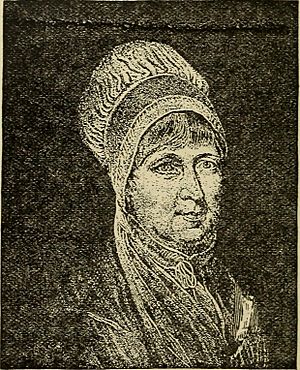Hester Rogers facts for kids
Quick facts for kids
Hester Rogers
|
|
|---|---|
 |
|
| Born | 31 January 1756 |
| Died | 10 October 1794 |
| Nationality | British |
| Known for | role model for women Methodists |
Hester Rogers (born January 31, 1756 – died October 10, 1794) was an important British writer and a key figure in the early Methodist movement. She is remembered as a great example for other women who followed the Methodist faith.
Her Early Life
Hester Ann Roe was born in Macclesfield, England, on January 31, 1756. She grew up in a family that was strict but also very caring. When she was 13 years old, she was confirmed into the Church of England by the Bishop of Chester, Edmund Keene.
Discovering Methodism
Hester's life changed significantly on November 11, 1774. She heard a preacher named Samuel Bardsley speak. He was one of the traveling preachers for John Wesley, who started the Methodist movement. After hearing him, Hester decided to become a Methodist.
She and another early Methodist, Ann Cutler, were among the first women to spread the Methodist message. They were known as evangelists, meaning they shared their religious beliefs with others.
A Dedicated Methodist Leader
In 1776, Hester met John Wesley, the founder of Methodism. This meeting began a long friendship and a lifelong exchange of letters between them. Hester became a Methodist class leader. This meant she led small groups of people who met to study the Bible and support each other in their faith. One of her students was Agnes Bulmer, who later became a well-known writer herself. Hester also spent time visiting people who were sick.
Five years later, Hester met another Methodist preacher named James Rogers and his wife, Ann. Sadly, James's wife died in February 1784 after giving birth. Following Ann's wishes, James and Hester married in August of the same year. After their marriage, they both traveled to Ireland to continue their work spreading the Methodist message.
Her Legacy
Hester Rogers passed away in Birmingham in 1794. After her death, a special sermon was published about her life. It was called The Character and Death of Mrs. Hester Ann Rogers. This sermon was given by Bishop Thomas Coke and included extra notes from her husband, James.
The sermon presented Hester Rogers' life as a role model for other Methodist women. It showed how she lived her faith and served others. By 1876, this sermon had been turned into a Methodist tract. A tract is a short booklet that shares religious teachings. Hester's story continued to inspire many people for a long time.

